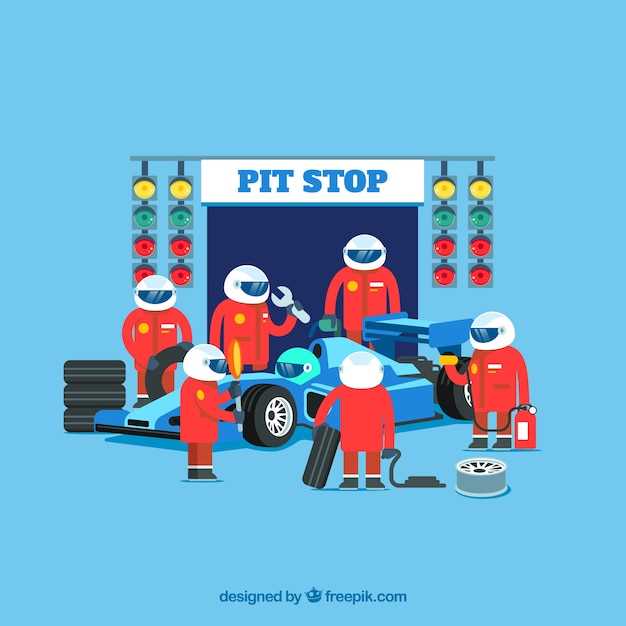
In the fast-paced world of motorsports, having an efficient and organized pit setup is crucial for ensuring optimal performance during race events. A portable pit box serves as the focal point of this setup, providing essential tools, spare parts, and workspaces in a compact and mobile form. Understanding how to create a customized pit box can significantly enhance your team’s readiness and efficiency on race day.
This guide will provide valuable insights into the necessary components and considerations for building your own portable pit box. From selecting durable materials to organizing essential tools and supplies, we will cover all aspects to help you construct a reliable and functional setup. Whether you’re a weekend racer or part of a professional team, a well-designed pit box can make all the difference in your race day success.
Furthermore, we will delve into practical tips on portability and mobility, ensuring that your pit box is easy to transport and set up at various racing venues. A well-crafted pit box not only supports efficiency but also creates a professional appearance that can positively impact team morale and performance. Get ready to elevate your racing experience with a thoughtfully designed portable pit box.
Choosing the Right Materials for Your Portable Pit Box
When building a portable pit box for race events, selecting the appropriate materials is crucial for durability, functionality, and ease of transport. A well-constructed box can protect your tools and gear from the elements while remaining lightweight enough for portability.
Start with the frame, which should be made from a sturdy yet lightweight material. Aluminum is an excellent choice due to its strength-to-weight ratio, ensuring the box can withstand the rigors of racing without adding unnecessary weight. Alternatively, high-density polyethylene (HDPE) offers excellent resistance to impact and is resistant to chemicals, making it suitable for holding automotive fluids or tools.
For the box’s exterior, consider using weather-resistant materials. Fiberglass or weather-treated wood can provide an appealing finish while protecting the contents from moisture. Ensure that all seams are sealed properly to prevent rain or spills from entering the box.
In terms of interior organization, opt for durable plastics or metal dividers that can keep your tools secure and sorted. Antimicrobial-treated materials can also help in keeping your tools cleaner, especially after a long day of racing.
Finally, don’t overlook the importance of the box’s closure mechanism. Heavy-duty latches or locks should be implemented to prevent accidental openings during transport. This will ensure that your tools are safe and ready for action when needed.
By carefully choosing the right materials, you can build a portable pit box that meets the demands of racing while ensuring your tools are protected and easily accessible.
Designing a Layout for Easy Access to Race Tools
Creating an efficient layout within your pit box is crucial for maximizing accessibility to race tools during events. A well-organized setup not only saves time but also reduces the risk of errors under pressure.
Start by assessing the types of tools required for your specific race scenarios. Group similar tools together, such as wrenches, screwdrivers, and power tools, to facilitate quick access. Use clear labeling for each section of the box, ensuring that team members can easily find what they need without wasting valuable time searching.
Next, consider the placement of frequently used items. Position commonly accessed tools at the front of the pit box or on a dedicated tool pegboard mounted on the door for instant visibility. This allows for quick retrieval while maintaining organization.
Utilize modular storage solutions like drawer organizers or tool rolls that can adapt to the various tools and components used in racing. This modularity provides flexibility, making it easy to modify the layout based on specific race requirements.
Leave ample space in your design for larger equipment, including fuel cans and tire changers. Ensure that these items are within reach but do not obstruct access to smaller tools. An orderly arrangement helps prevent accidents and keeps the work environment efficient.
Lastly, regularly evaluate and optimize the layout based on feedback from the team and experiences at different events. Continuous improvement will help keep your pit box functional and ready for any race day challenges.
Incorporating Storage Solutions for Spare Parts and Supplies
Creating an efficient and organized pit box for race events requires careful consideration of storage solutions for spare parts and tools. Incorporating dedicated compartments and containers helps maintain a clutter-free environment, ensuring that essential items are accessible during critical moments.
One effective approach is to implement modular storage systems that allow for easy customization and reconfiguration based on specific needs. Utilizing stackable bins with clear labels enables quick identification of contents, which is crucial when time is of the essence.
Additionally, a designated section for frequently used tools, such as wrenches, screwdrivers, and pliers, should be integrated into the pit box design. Tool organizers, such as foam inserts or magnetic tool holders, can prevent tools from shifting during transport and facilitate easy retrieval.
| Storage Solution | Benefits |
|---|---|
| Stackable Bins | Easy organization and transport; customizable layout for various parts |
| Drawer Units | Secure storage for smaller spare parts; easy access during repairs |
| Magnetic Tool Holders | Prevents tools from rolling or falling; quick access during races |
| Labeling Systems | Enhances efficiency in locating parts; reduces downtime |
Incorporating these storage solutions not only streamlines pit operations but also boosts overall race performance by minimizing time lost searching for tools and supplies. Prioritizing organization in the pit box will result in more effective teamwork and enhanced focus on race strategy.
Adding Mobility Features for Easy Transportation
To enhance the portability of your pit box, incorporating mobility features is essential for easy transportation to race events. Here are several tools and modifications that can make your pit box more mobile.
Firstly, consider equipping your pit box with sturdy wheels. Opt for large, durable wheels that can handle various terrains, such as gravel or grass. This feature allows for smooth movement and minimizes the effort required to transport the box from one location to another.
Secondly, adding a telescoping handle is a valuable enhancement. A handle that can extend and retract allows users to pull the box effortlessly, converting it from a stationary unit to a mobile one with minimal fuss. Ensure that the handle is ergonomically designed for comfort, especially during long events.
Another vital element is integrating a secure locking mechanism for your wheels. This feature ensures stability while the pit box is in use, preventing any accidental movement. Having locks that can be easily engaged and disengaged will greatly enhance convenience.
Weight distribution is also crucial. When designing the pit box, ensure that heavier tools and items are placed closer to the ground and the center of the box. This balance will make it easier to maneuver and reduce the risk of tipping over while in motion.
Finally, consider incorporating storage compartments that secure tools and equipment during transport. Compartments that are easily accessible will not only keep your tools organized but also prevent damage while on the move.
By implementing these mobility features, you can create a pit box that is not only practical but also highly functional for race events, ensuring that your tools and equipment are always at hand when needed.
Customizing Your Pit Box for Specific Race Needs

Creating a race-ready pit box involves tailoring it to meet the specific demands of your racing style and environment. Here are key considerations to help you customize your pit box effectively:
- Organizational Layout:
Design the interior of the pit box for maximum efficiency. Utilize compartments or shelves to separate tools, parts, and equipment. Consider using:
- Drawer organizers for hand tools
- Shelves for spare parts
- Baskets for safety gear
- Tool Selection:
Invest in high-quality tools specific to your race vehicle. Essential tools may include:
- Wrenches and sockets
- Tire-changing equipment
- Fuel containers
- Electrical and Communication Needs:
Incorporate solutions for power supply and communication devices. Consider these additions:
- Portable chargers for radios and devices
- LED lighting for nighttime visibility
- Portability:
Design the pit box to be easily transportable. Features to enhance portability might include:
- Wheels or casters
- Lightweight materials
- A collapsible or modular design
- Weather Resistance:
Protect your equipment from the elements. Choose waterproof materials and sealants to ensure:
- Durability in varied weather conditions
- Safe storage of sensitive equipment
- Personalization:
Customize the exterior to reflect your team identity. This can include:
- Team colors and logos
- Race numbers or symbols
By focusing on these areas, you can build a pit box that not only meets your specific race needs but also enhances your overall performance during events.
Maintaining Your Portable Pit Box for Longevity

Proper maintenance of your portable pit box is essential to ensure it withstands the rigorous demands of race events. Regular upkeep will not only enhance its durability but also optimize organization and accessibility of your tools.
Regular Cleaning: After each race, take time to clean your pit box thoroughly. Remove dust, dirt, and debris that may have accumulated during the event. Utilize a damp cloth for surfaces and a mild cleaner if necessary. Keeping the interior tidy will help prevent tools from getting damaged and will make it easier to find what you need quickly.
Check for Wear and Tear: Inspect your pit box regularly for signs of wear, such as rust on metal components or cracks in plastic sections. Address any issues immediately by replacing damaged parts or applying protective coatings to prevent further deterioration. This proactive approach ensures your box remains functional for future races.
Organize Tools Efficiently: An organized pit box is key to swift operations during races. Use dividers and containers to keep tools segregated by type and size. Regularly assess your tools and remove any that are broken or no longer needed, as clutter can hinder efficiency and increase the risk of misplacement.
Protective Measures: Consider investing in a weatherproof cover for your pit box if exposed to the elements. Additionally, secure any loose components to prevent them from shifting during transport, which can lead to damage. Taking preemptive steps protects your investment and maintains its usability.
Storage Properly: When your pit box is not in use, store it in a dry, cool environment. Extreme temperatures or moisture can lead to damage over time. Proper storage enhances the longevity of your unit and keeps your tools in optimal condition, ready for action when race day arrives.
By implementing these maintenance strategies, you can ensure your portable pit box remains a reliable companion throughout many race events, allowing you to focus on performance rather than equipment issues.




